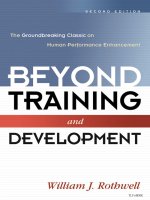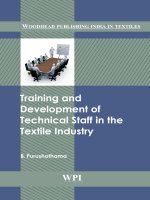Employee training and development 5th chapter 01
Bạn đang xem bản rút gọn của tài liệu. Xem và tải ngay bản đầy đủ của tài liệu tại đây (680.68 KB, 39 trang )
Chapter 1
Introduction to Employee
Training and Development
McGraw-Hill/Irwin
Copyright © 2010 by the McGraw-Hill Companies, Inc. All rights reserved.
What is Training?
Training - a planned effort by a company
to facilitate employees’ learning of jobrelated competencies.
Competencies include knowledge, skills or
behavior critical for successful job
performance.
The goal of training is for employees to
master the competencies and apply them
to their day-to-day activities.
1-2
What is Training? (cont.)
To use training to gain a competitive
advantage, a company should view
training broadly as a way to create
intellectual capital.
Intellectual capital includes basic skills
advanced skills an understanding of the
customer or manufacturing system, and
self-motivated creativity.
1-3
What is Training? (cont.)
High-leverage training
Is linked to strategic business goals and
objectives.
Uses an instructional design process to ensure
that training is effective.
Compares or benchmarks the company's
training programs against training programs
in other companies.
Creates working conditions that encourage
continuous learning.
1-4
What is Training? (cont.)
Continuous learning - requires
employees to understand the entire work
system, including the relationships
among their jobs, their work units, and
the company.
1-5
What is Training? (cont.)
Managers take an active role in:
Identifying training needs.
Ensuring that employees use training in their
work.
Facilitating the sharing of knowledge, by using
informational maps.
1-6
What is Training? (cont.)
Today, training is being evaluated on how
training addresses business needs related
to learning, behavior change, and
performance improvement.
1-7
What is Training? (cont.)
There is a greater emphasis on:
Providing educational opportunities for all
employees.
Performance improvement as an ongoing
process than a one-time training event.
Demonstrating to executives, managers, and
trainees the benefits of training.
Learning as a lifelong event.
Training being used to help attain strategic
business objectives.
1-8
Designing Effective Training
Training design process
A systematic approach for developing training
programs.
Is based on the principles of Instructional
System Design (ISD).
Is sometimes referred to as the ADDIE model
because it includes analysis, design,
development, implementation, and
evaluation.
Should be systematic yet flexible enough to
adapt to business needs.
1-9
Figure 1.1 - Training Design
Process
1-10
Designing Effective Training
(cont.)
Regardless of the specific ISD approach
used, all the steps share the following
assumptions:
Training design is effective only if it helps
employees reach their training objectives.
Measurable learning objectives should be
identified before the training program begins.
Evaluation plays an important part in planning
and choosing a training method, monitoring
the training program, and suggesting changes
to the training design process.
1-11
Designing Effective Training
(cont.)
Flaws of the ISD model:
In organizations, the training design process
rarely follows the step by-step approach of the
activities.
Organizations require trainers to provide
detailed documents of each activity found in
the model; this adds time and cost to
developing a training program.
It implies an end point: evaluation.
1-12
Table 1.1 - Forces Influencing
Working and Learning
1-13
Forces Influencing Working and
Learning
Economic cycles
Provide an opportunity for companies to take
a closer look at training and development to
identify those activities that are critical for
supporting the business strategy as well as
those mandated by law.
1-14
Forces Influencing Working and
Learning (cont.)
Globalization
Provide training and development
opportunities for global employees.
Provide cross-cultural training to prepare
employees and their families to understand
the culture and norms of the country to which
they are being relocated and assists in their
return to their home country after the
assignment.
1-15
Table 1.2 - Examples of
Intangible Assets
1-16
Forces Influencing Working and
Learning (cont.)
The value of intangible assets and human
capital has the following implication:
Focus on knowledge worker - employees
who contribute to the company not through
manual labor but through what they know,
perhaps about customers or a specialized
body of knowledge.
1-17
Forces Influencing Working and
Learning (cont.)
The value of intangible assets and human
capital has the following implication:
Employee engagement - the degree to
which employees are fully involved in their
work and the strength of their commitment to
their job and the company.
Companies measure employees' engagement
levels with attitude or opinion surveys.
1-18
Forces Influencing Working and
Learning (cont.)
The value of intangible assets and human
capital has the following implication:
Change - the adoption of a new idea or
behavior by a company.
Learning organization - embraces a culture
of lifelong learning, enabling all employees to
continually acquire and share knowledge.
1-19
Table 1.3 - How Managing Cultural Diversity can
Provide Competitive Advantage
1-20
Forces Influencing Working and
Learning (cont.)
Talent management - attracting,
retaining, developing, and motivating
highly skilled employees and managers.
It is becoming increasingly more
important because of:
occupational and job changes.
retirement of baby boomers.
skill requirements.
the need to develop leadership skills.
1-21
Forces Influencing Working and
Learning (cont.)
Customer service and quality emphasis
Total Quality Management (TQM) - a
companywide effort to continuously improve
the ways people, machines, and systems
accomplish work.
1-22
Forces Influencing Working and
Learning (cont.)
Core values of TQM
Methods and processes are designed to meet
the needs of internal and external customers.
Every employee in the company receives
training in quality, which is designed into a
product or service to prevent errors from
occurring rather than being detected and
corrected.
1-23
Forces Influencing Working and
Learning (cont.)
Core values of TQM
The company promotes cooperation with
vendors, suppliers, and customers to improve
quality and hold down costs.
Managers measure progress with feedback
based on data.
1-24
Forces Influencing Working and
Learning (cont.)
Customer service and quality emphasis
The Malcolm Baldrige National Quality
Award , created by public law, is the highest
level of national recognition for quality that a
U.S. company can receive.
The ISO 9000 is a family of standards that
include requirements for dealing with how to
establish quality standards and how to
document work processes to help companies
understand quality system requirements.
1-25









